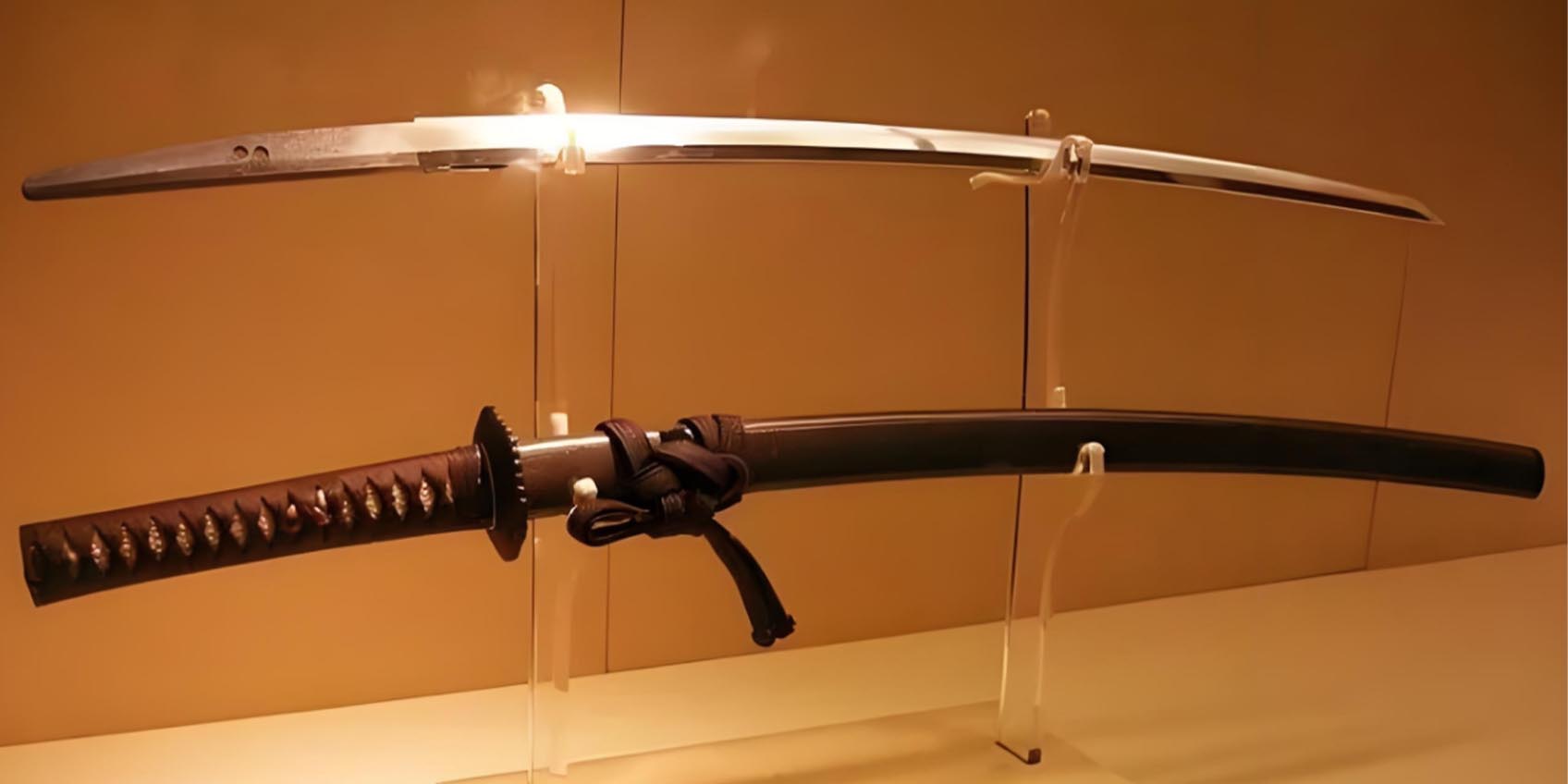คู่มือฉบับสมบูรณ์: ประวัติศาสตร์ งานฝีมือ และการใช้ดาบทาจิด้วยสองมือ

Katana กับ Tachi: การเปรียบเทียบอย่างรวดเร็ว
ทั้ง ทาจิ และ คาทานะ ถือเป็นดาบญี่ปุ่นที่มีเอกลักษณ์เฉพาะตัว แต่แตกต่างกันในด้านการออกแบบ การใช้งาน และบริบททางประวัติศาสตร์ ทาจิ จะยาวกว่า (70-80 ซม.) และมีส่วนโค้งที่เด่นชัดกว่า โดยจะสวมแบบปลายแหลมขึ้น ออกแบบมาเพื่อ ซามูไรที่ขี่ม้า ใน ช่วงยุคเฮอัน เหมาะอย่างยิ่งสำหรับ การฟัน ใน การต่อสู้ด้วยม้า ในทางตรงกันข้าม คาทานะ จะสั้นกว่า (60-80 ซม.) และมีส่วนโค้งที่เด่นชัดกว่า โดยจะสวมแบบปลายแหลมขึ้นเพื่อให้ ดึงดาบได้รวดเร็ว และ ต่อสู้ ระยะประชิด จึงได้รับความนิยมในยุคคามาคุระ คาทานะ ถูกสร้างขึ้นเพื่อ ความแม่นยำ และ การดวล ซึ่งเป็นสัญลักษณ์ของเกียรติยศ ของซามูไร ในยุค มุโระมาจิ และ เอโดะ โดยพื้นฐานแล้ว คาทานะ พัฒนามาจาก ทาจิ โดยปรับปรุงทักษะการใช้ดาบสำหรับรูปแบบการต่อสู้และยุคประวัติศาสตร์ที่แตกต่างกัน
จากสนามรบโบราณไปจนถึงการจัดแสดงใกล้กับ Tachi Palace Casino Resort ในแคลิฟอร์เนียตอนกลาง มรดกแห่งฝีมือการประดิษฐ์และพลังสองมือของดาบทาจิยังคงดำรงอยู่
Tachi เป็นดาบญี่ปุ่นแบบดั้งเดิมที่ได้รับการยกย่องว่ามีประวัติศาสตร์อันยาวนานและฝีมือการประดิษฐ์ที่ยอดเยี่ยม บทความนี้จะเจาะลึกถึง Tachi อันเลื่องชื่อ คุณลักษณะเฉพาะ กระบวนการผลิต และการใช้งานจริง
ดาบทาจิ สัญลักษณ์ของ ญี่ปุ่นในยุคศักดินา เป็น ดาบโค้ง ที่ปรากฏตัวครั้งแรกในช่วง ยุคเฮอัน และได้รับการพัฒนาจนกลายเป็นอาวุธที่ทั้งสวยงามและแม่นยำ ดาบทาจิแตกต่างจากดาบคาตานะตรงที่ดาบทาจิจะมี ลักษณะ ปลายดาบหันออกด้านนอก ตามแบบที่เรียกว่า ทาจิโคชิรา เอะ ทำให้มีประสิทธิภาพโดยเฉพาะในการต่อสู้บนหลังม้า การวางแนวดาบแบบนี้ทำให้ซามูไรสามารถดึงดาบได้อย่างรวดเร็วและโจมตีอย่างรุนแรงด้วย ดาบคมเดียว และ คมกริบที่ คมกริบ
ใน ช่วงยุคมุโระมาจิ เมื่อสงคราม ทวีความรุนแรงขึ้น ดาบที่เรียก ว่าทาจิก็ได้รับการเปลี่ยนแปลงครั้งสำคัญเพื่อตอบสนองความต้องการของกลยุทธ์การรบที่พัฒนาขึ้น การรุกรานญี่ปุ่นของพวกมองโกลถือ เป็นจุดเปลี่ยนที่ทำให้ ช่างตีดาบชาวญี่ปุ่น คิดค้นสิ่งใหม่ ๆ โดยสร้างดาบที่แข็งแกร่งและยืดหยุ่นมากขึ้น ซึ่งสามารถเจาะเกราะหนักของผู้รุกรานได้ การออกแบบดาบทาจิที่ยาวขึ้นและสง่างามยิ่งขึ้น ผสมผสานกับความสมดุลและฝีมือการประดิษฐ์ ทำให้ดาบทาจิกลายเป็นอาวุธที่นักรบขี่ม้าชื่นชอบ
แม้ว่าในที่สุดดาบทาจิก็ถูกแทนที่ด้วยดาบคาตานะในฐานะอาวุธที่ซามูไรนิยมใช้ แต่ตำนาน ดาบคาตานะในฐานะดาบโค้ง อันยอดเยี่ยมก็ยังคงอยู่ ฝีมือการประดิษฐ์ดาบของ ช่างตีดาบชาวญี่ปุ่น ซึ่งพัฒนาเทคนิคจนสมบูรณ์แบบเพื่อสร้างดาบทาจิที่มีรูปร่างและการใช้งานที่โดดเด่น ยังคงเป็นเครื่องพิสูจน์ถึงบทบาทของอาวุธชนิดนี้ในการสร้างประวัติศาสตร์การต่อสู้และวัฒนธรรมของ ญี่ปุ่นในยุคศักดินา
ตำนานแห่งทาจิ
Tachi เป็นอาวุธคลาสสิกของญี่ปุ่นที่มีความโค้งมนอย่างเห็นได้ชัด โดยทั่วไปมีความยาวระหว่าง 3 ถึง 5 shaku อาวุธขนาดเล็กเรียกว่า Ko-tachi ส่วนอาวุธขนาดใหญ่เรียกว่า O-tachi หรือ Yatachi เชื่อกันว่าคำว่า 'Tachi' มีที่มาจากคำภาษาญี่ปุ่นที่แปลว่า 'ตัด' ('tachi') แม้ว่าการค้นพบทางโบราณคดีและบันทึกทางประวัติศาสตร์จะชี้ให้เห็นว่าการออกเสียงนั้นแตกต่างกันไปในยุคแรกๆ Tachi พัฒนามาจากดาบด้ามยาวแบบแหวนในสมัยราชวงศ์ฮั่นของจีน ซึ่งแสดงให้เห็นถึงรากฐานทางประวัติศาสตร์อันล้ำลึก
กระบวนการผลิต: ห้าขั้นตอนของการสร้างสรรค์
- การหลอมเบื้องต้น : ผสมทรายเหล็กกับผงควอตซ์และผงถ่าน จากนั้นให้ความร้อนในเตาเผาแบบเหยียบด้วยเท้าเป็นเวลาสามวันสามคืน ทรายเหล็กจะเปลี่ยนเป็นเนื้อเหนียวกึ่งหลอมเหลว จากนั้นจึงทำให้เย็นลงและแข็งตัวเป็นเหล็กแท่งรูปแท่ง
- การปรับปรุง : บดแท่งเหล็กดิบ ผสมควอตซ์และผงถ่านเพิ่ม แล้วให้ความร้อนอีกครั้งเพื่อหลอม กระบวนการนี้ผลิต Tamahagane ซึ่งเป็นเหล็กกล้าคาร์บอนสูง
- การก่อตัวของเหล็กกล้าอ่อน : ผ่านการดับและการกลั่นซ้ำแล้วซ้ำเล่า Tamahagane จะถูกแปลงเป็น เหล็กกล้าอ่อน ซึ่งให้ความยืดหยุ่นและความเหนียวที่จำเป็นสำหรับแกนดาบ
- ใบมีดชุบแข็ง : แกนเหล็กอ่อนหุ้มด้วยชั้นของ Tamahagane ที่มีความแข็งกว่า (เรียกว่า ' Kawa-ite' ) และสันของใบมีดหุ้มด้วย Tamahagane ที่มีคาร์บอนสูง (เรียกว่า ' Mune-ite' ) การชุบแข็งและการทำให้ละเอียดยิ่งขึ้นทำให้ใบมีดมีรูปร่างเบื้องต้นที่สมบูรณ์
- การชุบแข็งด้วยดินเหนียว : ใบมีดจะถูกชุบแข็งด้วยดินเหนียวเพื่อให้ได้ขอบที่คมและแข็ง
ดาบ Tachi ที่สร้างเสร็จแล้วสะท้อนให้เห็นถึงความชำนาญและความพยายามอย่างพิถีพิถันของช่างตีดาบ
ลักษณะโครงสร้าง
ดาบทาจิแตกต่างจากดาบชนิดอื่น เช่น ดาบคาตานะ โดยเฉพาะฝักดาบที่มีห่วงโลหะสองวง (เรียกว่า ' โคซูกะ' ) มัดด้วยริบบิ้นเพื่อให้พกพาได้สะดวก หัวฝักดาบหุ้มด้วยโลหะ (เรียกว่า ' อิชิดาชิ' ) และต้องกดชิ้นส่วนโลหะที่ปากฝักดาบ (เรียกว่า ' คุชิคิริ' ) ลงเมื่อดึงดาบ ดาบทาจิในยุคแรกใช้โดยทหารม้าเป็นหลัก ซึ่งเน้นย้ำถึงความแข็งแกร่งและทักษะของซามูไร การออกแบบใบมีดโค้งทำให้การฟันมีประสิทธิภาพมากขึ้น โดยสืบทอดรูปร่างโค้งของ ดาบทาจิแบบโคซูกะ ในยุคแรก
เทคนิคการใช้ทาจิ
การจับที่ถูกต้องเป็นสิ่งสำคัญเมื่อใช้ Tachi มือไม่ควรมีช่องว่าง นิ้วนางและนิ้วก้อยควรจับด้ามจับให้แน่น ในขณะที่นิ้วหัวแม่มือและนิ้วชี้จับด้ามจับเบาๆ โดยให้นิ้วกลางพักตามธรรมชาติ
ระหว่างการโจมตี ควรจับให้แน่นเพื่อไม่ให้สั่นหรือลังเล การจับต้องปรับเปลี่ยนเพียงเล็กน้อยระหว่างการโจมตี การบล็อค หรือการกดใบมีดของคู่ต่อสู้ แต่เป้าหมายควรเป็นการเอาชนะคู่ต่อสู้เสมอ
การฝึกฝนการใช้ Tachi ต้องใช้การควบคุมที่ยืดหยุ่น หลีกเลี่ยงการแกว่งแบบคงที่หรือรวดเร็ว การแกว่งอย่างรวดเร็วจะคล้ายกับการเคลื่อนไหวของพัด และไม่เหมาะกับการใช้ Tachi วิธีการที่ถูกต้องคือการเคลื่อนไหวที่นุ่มนวลและทรงพลัง เทคนิคการแกว่งอย่างรวดเร็วที่เรียกว่า ' Sokuto' ไม่เหมาะสำหรับการโจมตีศัตรูด้วย Tachi ซึ่งควรใช้กับการเคลื่อนไหวที่ลื่นไหลและรุนแรง
ทำไมซามูไรถึงเลิกใช้ทาจิ
การเสื่อมถอยของ Tachi เป็นผลมาจากการเปลี่ยนแปลงวิธีการต่อสู้เป็นหลัก ปัจจัยสำคัญ ได้แก่:
- การเปลี่ยนแปลงวิธีการต่อสู้ : ในช่วงยุคเซ็นโกกุ (ค.ศ. 1467–1603) การต่อสู้เปลี่ยนจากการใช้ทหารม้าเป็นทหารราบ การออกแบบของทาจิไม่เหมาะกับความต้องการใหม่ๆ ของการต่อสู้ของทหารราบอีกต่อไป ซึ่งต้องใช้อาวุธที่เร็วและคล่องตัวกว่า
- การกำเนิดของดาบคาทานะ : ดาบคาทานะถือกำเนิดขึ้นในช่วงยุคคามาคุระ (ค.ศ. 1185–1333) และกลายมาเป็นอาวุธหลักในยุคเซ็นโกกุ ดาบคาทานะเหมาะกับการต่อสู้ของทหารราบมากกว่าเนื่องจากการออกแบบที่ทำให้สามารถดึงอาวุธออกมาได้อย่างรวดเร็วและโจมตีได้อย่างรวดเร็ว
- ข้อจำกัดในการออกแบบ : ดาบ Tachi ที่ใบดาบห้อยลงนั้นเหมาะสำหรับการโจมตีบนหลังม้า แต่มีประสิทธิภาพและความยืดหยุ่นน้อยกว่าในการต่อสู้กับทหารราบเมื่อเทียบกับดาบคาทานะ
บทสรุป
ดาบทาจิไม่ได้เป็นเพียงอาวุธ แต่ยังเป็นสัญลักษณ์ของประเพณีและศิลปะของซามูไรญี่ปุ่น กระบวนการผลิตที่ซับซ้อน การออกแบบที่เป็นเอกลักษณ์ และเทคนิคการใช้งานเน้นย้ำถึงทักษะและความทุ่มเทของช่างตีดาบ สำหรับผู้ที่ชื่นชอบและนักสะสม การทำความเข้าใจประวัติศาสตร์และฝีมือของดาบทาจิจะช่วยส่งเสริมให้ชื่นชมวัฒนธรรมดาบญี่ปุ่นมากยิ่งขึ้น สำรวจโลกของดาบทาจิและสัมผัสกับมรดกอันล้ำค่าของดาบในตำนานเล่มนี้
ดาบญี่ปุ่นทาจิ – ใบมีดเต็มใบพร้อมอุปกรณ์ลวดลายมังกร
CoolKatana ขอนำเสนอ ดาบทาจิแบบทำมือของญี่ปุ่น สำหรับผู้ชื่นชอบดาบ ดาบนี้ประดิษฐ์จาก เหล็กกล้าคาร์บอน 1045 มีใบมีดแบบเต็มความยาวและลวดลายมังกรอันวิจิตรบรรจง แสดงให้เห็นถึงฝีมืออันยอดเยี่ยมและความทนทาน ในฐานะของ ดาบคาทานะสำหรับการต่อสู้ ดาบ นี้เลียนแบบการออกแบบทาจิแบบดั้งเดิมได้อย่างแท้จริงในขณะที่ผสมผสานเทคนิคสมัยใหม่ สะท้อนให้เห็นถึงศิลปะ การออกแบบดาบ และงานฝีมือ
ไม่ว่าคุณจะต้องการ ดาบคาทานะ ของแท้หรือต้องการสำรวจการออกแบบส่วนประกอบของดาบ ( ชิ้นส่วนของดาบ ) ซีรีส์ดาบ Tachi นี้จะตอบโจทย์ความต้องการของคุณ ผลิตจาก เหล็กกล้าคาร์บอน 1045 ใบดาบมีความแข็งและทนทาน และมีตัวเลือกการปรับแต่งเพื่อสร้าง ดาบที่กำหนดเองที่ ไม่ซ้ำใคร รายละเอียดแต่ละอย่างตั้งแต่ ด้ามจับของดาบ ไปจนถึง ด้ามดาบ ได้รับการออกแบบอย่างพิถีพิถันเพื่อตอบสนองความต้องการของนักสะสมและผู้ที่ชื่นชอบที่ต้องการ ดาบคาทานะที่สมจริง
ดาบทาจิทำมือของญี่ปุ่นนี้ไม่เพียงแต่เป็นตัวเลือกที่เหมาะสำหรับผู้ชื่นชอบดาบเท่านั้น แต่ยังเป็นสิ่งที่ต้องมีสำหรับนักสะสม ดาบอนิ เมะอีกด้วย สำหรับผู้ที่สนใจ ชื่อดาบ และทาจิแบบดั้งเดิม ( ดาบคาทานะ ) ดาบเล่มนี้แสดงให้เห็นถึงความเข้าใจอย่างลึกซึ้งเกี่ยวกับ ส่วนประกอบของคาทานะ และฝีมือ การออกแบบดาบ ที่ยอดเยี่ยม หากคุณเป็นแฟนของดาบทำมือ ดาบทาจิเล่มนี้จะเป็นส่วนเสริมอันทรงคุณค่าในคอลเลกชันของคุณอย่างไม่ต้องสงสัย
นักรบซามูไร สวมดาบคาทานะ ใน สมัยเอโดะ ซึ่งเป็นช่วงที่ศิลปะการฟันดาบได้รับความนิยมสูงสุด ดาบทาจิจะสวมโดยให้ขอบดาบหงายขึ้น ซึ่งต่างจากดาบคาทา นะ ที่สวมโดยให้ขอบดาบหงายขึ้น ซึ่งทำให้ซามูไรดึงดาบออกมาได้อย่างรวดเร็วเพื่อ ต่อสู้ระยะประชิด การออกแบบนี้ทำให้ดาบทาจิเหมาะสำหรับนักรบที่ขี่ม้า เนื่องจากสามารถดึงออกมาได้ง่ายในขณะขี่ม้า
ฝีมือการประดิษฐ์ ดาบทาจิเป็นเครื่องพิสูจน์ทักษะของช่างตีดาบชาวญี่ปุ่น ในยุคเอโดะ ช่างตีดาบได้พัฒนาเทคนิคของตนเพื่อสร้างดาบที่ไม่เพียงแต่ใช้งานได้จริงเท่านั้น แต่ยังเป็นงานศิลปะอีกด้วย โดยผสมผสานฮามอน (เส้นเทมเปอร์) ที่ซับซ้อนและความโค้งที่โดดเด่น ดาบเหล่านี้มักจะยาวกว่าคาตานะ ทำให้สามารถเอื้อมถึงได้ไกลขึ้นในการต่อสู้
การใช้ดาบทาจิสองมือ ต้องอาศัยความสมดุลระหว่างความแข็งแกร่งและความแม่นยำอย่างเชี่ยวชาญ ดาบทาจิแตกต่างจากดาบมือเดียวตรงที่ดาบทาจิสามารถโจมตีได้อย่างรุนแรงและกว้างไกล ทำให้มีประสิทธิภาพสูงทั้งในการรุกและรับ ขนาดและน้ำหนักของดาบทาจิต้องใช้ความชำนาญระดับสูง จึงกลายมาเป็นสัญลักษณ์ของสถานะและความสามารถในการต่อสู้ของซามูไร
ดาบทาจิญี่ปุ่นทำมือ ใบมีดเหล็กกล้าคาร์บอน 1045 ทรงเต็มใบ พร้อมอุปกรณ์ตกแต่งลายมังกร
ในงานอีเวนต์บางงาน แฟนๆ จะแสดงทักษะการใช้ดาบเพื่อเป็นการยกย่องให้กับการต่อสู้ในตำนานของอนิเมะ นอกจากนี้ งานอีเวนต์ยังจัดการแข่งขันการใช้ดาบเพื่อให้ผู้ที่ชื่นชอบได้แสดงความหลงใหลและความคิดสร้างสรรค์ด้วยอาวุธอันโด่งดังเหล่านี้ อาวุธอนิเมะบางประเภทมีความสำคัญเป็นพิเศษสำหรับแฟนๆ โดยมีอิทธิพลต่อการใช้ดาบในอนิเมะและจุดประกายความสนใจในสินค้าที่เกี่ยวข้อง การเฉลิมฉลองในงานอีเวนต์อนิเมะต่างๆ จะช่วยส่งเสริมความนิยมของอาวุธเหล่านี้ให้เพิ่มมากขึ้น อาวุธเหล่านี้เป็นสัญลักษณ์ของความแข็งแกร่งและความกล้าหาญ ซึ่งทิ้งร่องรอยอันยาวนานไว้ในโลกอนิเมะ




